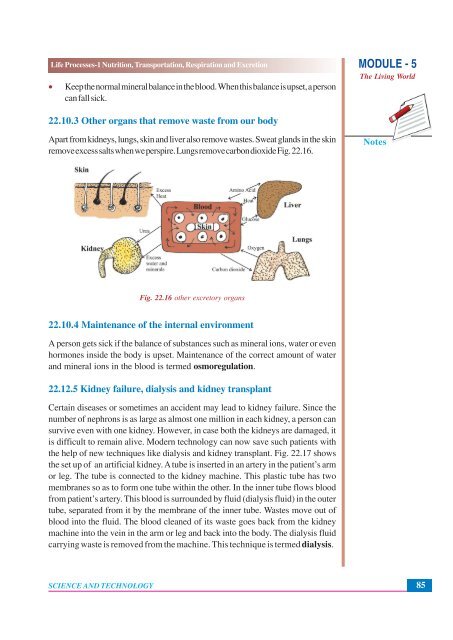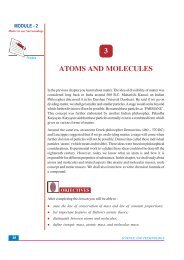Nutrition, Transportation, Respiration and Excretion
Nutrition, Transportation, Respiration and Excretion
Nutrition, Transportation, Respiration and Excretion
You also want an ePaper? Increase the reach of your titles
YUMPU automatically turns print PDFs into web optimized ePapers that Google loves.
Life Processes-1 <strong>Nutrition</strong>, <strong>Transportation</strong>, <strong>Respiration</strong> <strong>and</strong> <strong>Excretion</strong><br />
• Keep the normal mineral balance in the blood. When this balance is upset, a person<br />
can fall sick.<br />
MODULE - 5<br />
The Living World<br />
22.10.3 Other organs that remove waste from our body<br />
Apart from kidneys, lungs, skin <strong>and</strong> liver also remove wastes. Sweat gl<strong>and</strong>s in the skin<br />
remove excess salts when we perspire. Lungs remove carbon dioxide Fig. 22.16.<br />
Notes<br />
Fig. 22.16 other excretory organs<br />
22.10.4 Maintenance of the internal environment<br />
A person gets sick if the balance of substances such as mineral ions, water or even<br />
hormones inside the body is upset. Maintenance of the correct amount of water<br />
<strong>and</strong> mineral ions in the blood is termed osmoregulation.<br />
22.12.5 Kidney failure, dialysis <strong>and</strong> kidney transplant<br />
Certain diseases or sometimes an accident may lead to kidney failure. Since the<br />
number of nephrons is as large as almost one million in each kidney, a person can<br />
survive even with one kidney. However, in case both the kidneys are damaged, it<br />
is difficult to remain alive. Modern technology can now save such patients with<br />
the help of new techniques like dialysis <strong>and</strong> kidney transplant. Fig. 22.17 shows<br />
the set up of an artificial kidney. A tube is inserted in an artery in the patient’s arm<br />
or leg. The tube is connected to the kidney machine. This plastic tube has two<br />
membranes so as to form one tube within the other. In the inner tube flows blood<br />
from patient’s artery. This blood is surrounded by fluid (dialysis fluid) in the outer<br />
tube, separated from it by the membrane of the inner tube. Wastes move out of<br />
blood into the fluid. The blood cleaned of its waste goes back from the kidney<br />
machine into the vein in the arm or leg <strong>and</strong> back into the body. The dialysis fluid<br />
carrying waste is removed from the machine. This technique is termed dialysis.<br />
SCIENCE AND TECHNOLOGY<br />
85
















